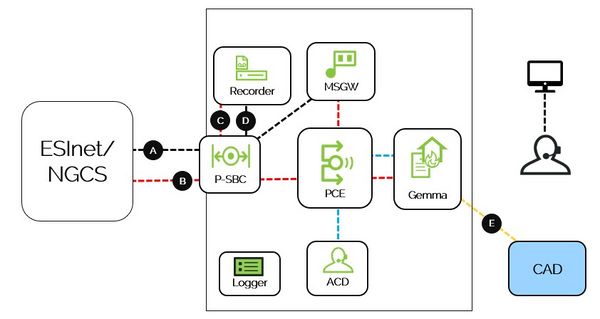Developer Program - OpenScape First Response PSAP Solution
The Wiki of Unify contains information on clients and devices, communications systems and unified communications. - Unify GmbH & Co. KG is a Trademark Licensee of Siemens AG.
Atos develops NG9-1-1 solutions based on NENA and ETSI/EENA standards. This ensures that we are compatible with other vendors which follow the same approach to ensure our clients can operate in a mixed standards-based environment when transitioning from an old to a new system. The components in the OpenScape First Response PSAP Solution are implemented based on NENA standards and is designed for deployment in North America.
To validate interoperability, Atos participates in industry events, such as NENA ICE and EENA Plugtest sessions.
All external interfaces provided by the solution will be compliant to the applicable standards. This page will enumerate these interfaces and describe which standards apply. Internal interfaces between solution components provide by Unify/Atos will not be described here.
A. Media through the P-SBC via the RTP Interface
The PSAP Session Border Controller (P-SBC) resides at the entry point to the OSFR PSAP Solution from the ESInet and provides a secure entry point into and out of the PSAP from outside networks. The Border Control Function (BCF) incorporates firewall and Session Border Controller (SBC) functions, and may include other security functions, including functions designed to recognize and block external attacks on PSAP infrastructure.
The media for all emergency calls entering the OSFR PSAP Solution are carried using Real-Time Transport Protocol (RTP), with the exception of Text-to-911 calls where the message contents are carried via MSRP (Message Session Relay Protocol). Media carried via RTP include voice, video and Real-Time Text (RTT).
Refer to the NENA i3 documents 08-002 [3] and NENA-STA-010[4] for a detailed description of BCF functionality and interfaces. The RTP interface is compliant to RFC 3550.
B. Calls through the P-SBC via the SIP Interface
The PSAP Session Border Controller (P-SBC) resides at the entry point to the OSFR PSAP Solution from the ESInet and provides a secure entry point into and out of the PSAP from outside networks. The Border Control Function (BCF) incorporates firewall and Session Border Controller (SBC) functions, and may include other security functions, including functions designed to recognize and block external attacks on PSAP infrastructure.
Emergency calls entering the OSFR PSAP Solution are signaled via the Session Initiation Protocol (SIP). All calls traversing this interface will have the additional SIP headers as required by the NENA and ETSI/EENA specifications (Emergency Call-ID, Incident-ID, Resource-Priority, and any necessary Call-Info headers).
Refer to the NENA i3 documents 08-002 [3] and NENA-STA-010[4] for a detailed description of BCF functionality and interfaces. The SIP interface is compliant with RFC 3261 and to the relevant sections of the NENA i3 document and ETSI TS 103 479.
C. SIPREC Recording Call Control Interface
In order to record emergency calls being handled by PSAP solutions, NENA standards define interface between the PSAP Session Border Controller (P-SBC) and recording equipment. The Border Control Function (BCF) within the P-SBC provides for connecting to SIPREC Recording Servers (SRS). The recording call control interface utilizes a set of extensions to the SIP protocol, known as SIPREC, which are defined in RFC 7866. Besides the actual recording control, SIPREC specifies meta-data which are sent as XML MIMEs in SIP messages and stored by the SRS.
D. SIPREC Recording Media Interface
In order to record emergency calls being handled by PSAP solutions, NENA standards define interface between the PSAP Session Border Controller (P-SBC) and recording equipment. The Border Control Function (BCF) within the P-SBC provides for connecting to SIPREC Recording Servers (SRS). The recording media interface is capable of transmitting RTP (as defined in RFC 3550) for voice, video and RTT calls, and MSRP (as defined in RFC 4795) for text calls.
E. Computer Aided Dispatch (CAD) Interface
The OSFR PSAP Solution CAD interface allows other system devices to interface with emergency call information. At a minimum it will provide the retrieved ALI for an emergency call as well as the answering position identification.
The OSFR PSAP Solution is compliant with NENA-STA-027.3-2018 and the CAD interface specified in Sec. 3.3 of STA-027.3. In addition to a TIA-232 interface, the solution also supports an IP interface to CAD systems. The data flow follows NENA standards with location data (PIDF-LO structure or traditional ALI) transmitted in the format it was received from the NGCS or other location provider. This allows CAD systems to parse and extract all relevant data.




